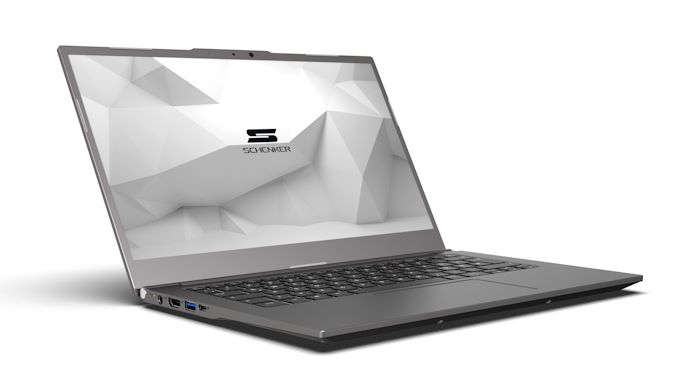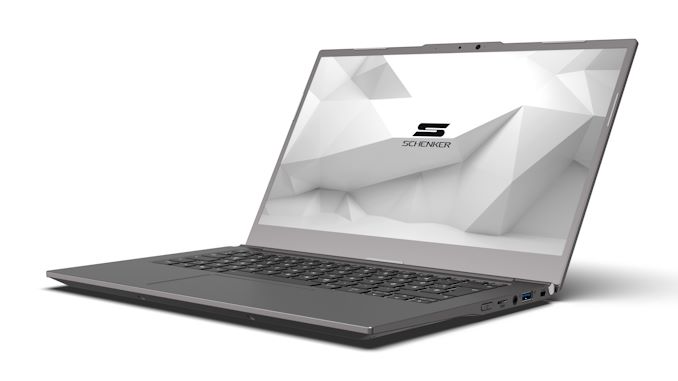Schenker VIA 14: 14-inch Tiger Lake Magnesium Notebook, with 28W Version Inbound
by Dr. Ian Cutress on September 2, 2020 1:00 PM EST
With Intel lifting the lid on its new Tiger Lake mobile processors today, a number of vendors are announcing their upcoming notebooks. Schenker Technologies, a German brand known in Europe for its Xtreme Mobile Gaming (XMG) line of products and custom Clevo implementations, is one of the first to describe an upcoming 11th Gen Intel Tiger Lake portable notebook as part of its VIA line. With a lightweight magnesium chassis, the VIA 14 uses up to a Core i7, a 73 Wh battery, and a one watt display to give 14+ hours of battery life.
The key thing to note about Tiger Lake is the increase in both CPU and GPU performance compared to the previous generation Intel notebook processors. We still have four cores, but the Tiger Lake cores can now boost a lot higher due to Intel’s improved 10nm SuperFin process (which you can read about here). Tiger Lake is Intel’s first product with its new Xe-LP graphics design as well, promising 2x the graphics performance of the last generation. The goal with these processors is to enable a nice and comfortable experience in a range of designs from ultra-premium to the run-of-the-mill.
The Schenker VIA 14 sits in that ultra-premium market. Using a lightweight magnesium chassis, the kind that we only ever see on the expensive end of the market, the VIA 14 is claiming only a 1.1 kg (2.4 lbs) weight despite also putting a 73 Wh battery inside. Personally I find this a bit mind blowing, if I’m honest. A 73 watt-hour battery in a 1.1 kg notebook is insane, and they are also claiming a 90% charge in 90 minutes. Not only that, but there’s also one of Intel’s approved low-power one-watt displays, enabling 14+ hours of active battery life according to the press release when at 150 nits.
Tiger Lake also enables PCIe 4.0 storage, native Thunderbolt 4, and Schenker will also support an optional LTE modem for business customers. Despite being lightweight, the big battery means the notebook is 16.5 mm, but with a 14-inch display is still very portable. The ports with the VIA 14 include a HDMI 2.0b connection, a USB 4.0/Thunderbolt 4 Type-C with DisplayPort 1.4b support, two USB-A 3.2 ports, a microSD card reader and a combination headphone jack. Native connectivity is through Wi-Fi 6, and as mentioned, an LTE add-on is supported.
For storage, the VIA 14 has support for two M.2 SSDs, one at PCIe 4.0 and the other at PCIe 3.0. Memory is DDR4-3200, with 8 GB coming pre-soldered and an 8 GB SO-DIMM module coming as standard, however up to 40 GB total memory can be supported. The 14-inch display has a maximum brightness of 300 nits and provides 98% coverage – Schenker says the special ‘one-watt’ display applies when running at 150 nits. The display also opens to a 180-degree hinge.
Prices for the VIA 14 will start at €1,246.75 (that includes 16% VAT) at the end of October. The base model features the Core i7-1165G7, 8 GB DDR4, and a 250 GB Samsung 860 Evo SSD, and models with the Core i5-1135G7 will follow later.
Schenker also included a preview of what is to come, simply stating that a version with a 28 W Tiger Lake processor paired with an NVIDIA graphics card will be ‘coming soon’.
Related Reading
- Intel’s 11th Gen Core Tiger Lake SoC Detailed: SuperFin, Willow Cove and Xe-LP
- Intel Schedules Tiger Lake Architecture Presentation For August 13th, Launch on September 2nd
- Hot Chips 2020 Live Blog: Intel's Tiger Lake Mobile CPU (12:30pm PT)
- Intel Thunderbolt 4 Update: Controllers and Tiger Lake in 2020
- I Ran Off with Intel’s Tiger Lake Wafer. Who Wants a Die Shot?











33 Comments
View All Comments
deil - Thursday, September 3, 2020 - link
its a baseline for cheapest. HOPEFULLY upgradable.trivik12 - Wednesday, September 2, 2020 - link
I am impressed by how light the 14" laptops are today. Other good thing about the specs are we are seeing laptops with USB-A and HDMI ports in a lightweight laptop. That is great news. Plus the screens seem to be of great quality(some of them 100% DCI-P3) and we even have a laptop with 1080p OLED that is hopefully very efficient as well.Unashamed_unoriginal_username_x86 - Wednesday, September 2, 2020 - link
1250 euros with 256gb storage, you come to Eric Wareheim when you want fine European prices...jho1670 - Wednesday, September 2, 2020 - link
I really want fullsized sdcard readers. Does everyone actually only use microSD, and why would an adapter be insufficient? I keep seeing 14" laptops that have microSD card readers, forcing me over to use an external card reader. Why?smilingcrow - Wednesday, September 2, 2020 - link
Because Smart Phones drive consumer IT and they support micro if anything.Plus you can get so much on a micro card these days that full size are generally an irrelevance.
vladx - Wednesday, September 2, 2020 - link
I prefer microSD because it doesn't stick out, I would rather use an SD adapter to put it in a camera.notb - Wednesday, September 2, 2020 - link
Frankly, yes. You're expected to use an adapter.The thinking behind this is that if you need SD, you're probably an avid photographer. So you have the money and buying an adapter probably isn't a big deal. But this is a very small group today.
Most consumer devices moved to microSD (phones, compact cameras, drones, mini computers).
And since these built-in card readers are usually fairly slow, so you're still better off using an adapter - making the built-in reader more of a convenient alternative on the go.
GNUminex_l_cowsay - Wednesday, September 2, 2020 - link
Power buttons on the side of the laptop are a massive nuisance.eastcoast_pete - Wednesday, September 2, 2020 - link
Thanks Ian! I don't find a 73 Wh battery in a lightweight ultraportable "mind-blowing", I think it's great! After all, an ultraportable is only fully mobile until it needs to be plugged in. Good for Schenker to not skimp on battery. Really hope other makers of ultraportable laptops follow that lead.nils_ - Thursday, September 3, 2020 - link
It's a shame, specs sound great until you get to the single TB/USB4 port and soldered RAM...